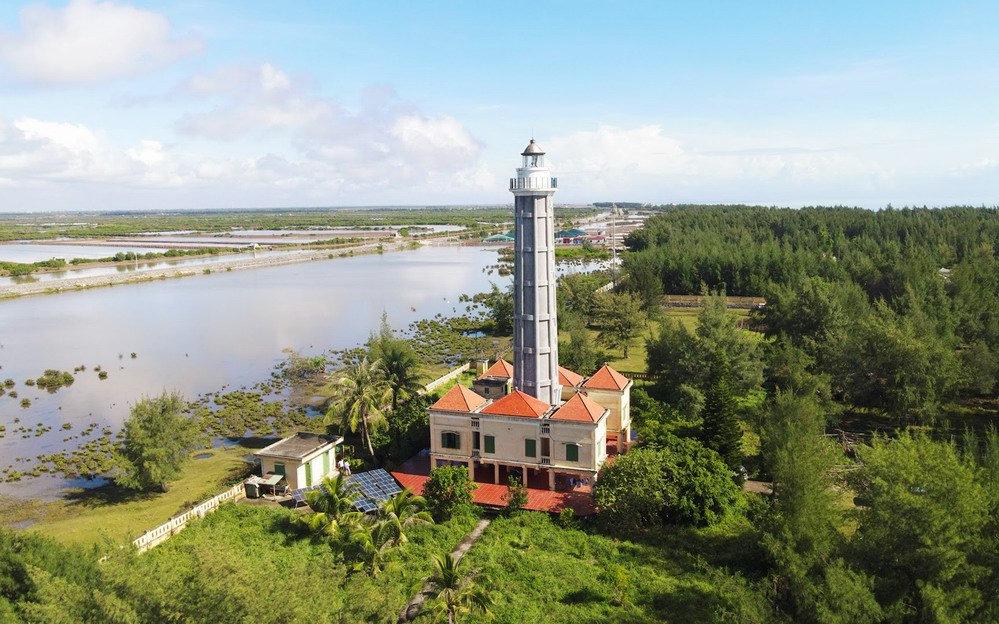Ba Lat estuary in Nam Dinh
Talking about famous places in Nam Dinh, we cannot ignore the name of Ba Lat estuary. This is the meeting place between the Red River and the East Sea with majestic scenery of rivers, seas, clouds and sky. When visiting Ba Lat estuary, you will also experience many other activities and famous tourist destinations.

Where is Ba Lat estuary located?
Ba Lat estuary is a seaport in the Northern region, where the Red River flows
into the Gulf of Tonkin. Ba Lat estuary is located between Giao Thuy district,
Nam Dinh province on the right bank of the southern bank and Tien Hai district,
Thai Binh province on the left bank of the northern bank. The land on the
northern bank is called Con Vanh in Tien Hai district, and the land on the
southern bank is Con Lu in Giao Thuy district. Right at the mouth of Ba Lat
estuary, there is a lighthouse up to 38 m high and was built in 1962 to help
ships navigate safely.
Learn about Ba Lat gate Nam Dinh
According to rumors, the name of Ba Lat estuary originated from the famine of
1945, when the bodies of the starving people had no place to be buried, so they
had to be tied with 3 bamboo strips and released into the Red River to the sea.
Many other stories say that the name Ba Lat originated from ancient times when
the river estuary was divided into 3 small branches and not like it is now.
According to other documents, the name Ba Lat belongs to an ancient village.
According to historical records, the Red River used to flow through Ha Lan
estuary to the sea, at this time Giao Thuy was still on the left bank. Ba Lat at
this time was just a small creek, from one bank to the other was only separated
by a bamboo bridge tied with three bamboo strips. During the Le Dynasty, Binh
Ngo year, the Red River flowed into Ngu Ham River through Ha Lan estuary, until
1787 the event of "earth crust tectonics" took place, causing Ba Lat to expand
and become a river mouth, historical books called "Ba Lat breaking festival".
Giao Thuy land from the left bank became the right bank of the Red River, Ba Lat
estuary was widened while Ha Lan estuary was narrowed. After the "Hoi pha Ba
Lat", villages from Ha Nam, Giao Huong commune to the Red River estuary were
deposited with alluvium up to tens of thousands of hectares. The communes of
Giao Tien, Giao Tan (Giao Thuy), Tho Nghiep, Xuan Hoa, Xuan Vinh were built by
the people to prevent saltwater intrusion, creating many fertile fields.
How to get there
As a province without an airport, when traveling to Nam Dinh you can choose many
means of transport such as motorbike, bus, taxi. For those who live far away,
the best way is to book a flight to Hanoi , then from Hanoi travel to Nam Dinh
by means such as bus, train.
From Nam Dinh city, you follow Highway 21 through Lac Quan bridge (Ninh Co
river) to Co Le town, then Ngo Dong town in Giao Thuy district, go another 10km
to Ba Lat estuary. From Ngo Dong town to Ba Lat estuary is a flat asphalt road
that is very easy to travel, surrounded by vast fields and many ancient
architectural works that are worth visiting. Because Ba Lat estuary is a natural
tourist destination, before going, remember to carefully research the route,
accommodation,...
Attractions near Ba Lat estuary
Coming to Ba Lat estuary area, you will be surprised with the interesting
experiences here.
Xuan Thuy National Park
Xuan Thuy National Park is one of the reasons why many people want to visit Ba
Lat estuary. The alluvium from the Red River and the sea has created a wetland
for many species of wild animals and rare migratory birds to live. This place
provides a variety of aquatic products for migratory birds from the North.
Therefore, many tourists come here and want to take pictures of these birds.
Visit ancient buildings
Next to the Ba Lat river mouth, you should try walking to learn about the
culture, lifestyle and architecture here. Especially in Giao Thien and Giao An,
there is a church that is over 100 years old. The unique, ancient and
distinctive design of the church creates a lasting impression when admiring it.
Experience fishing and catching clam with fishermen
When visiting Ba Lat estuary, you can also transform into real fishermen, join
in catching fish, catching crabs, raking clams,... with the locals here. This is
the best way to learn more about the daily life of the people, feel the
difficulties in their livelihood. Don't forget to enjoy the rustic seafood
dishes here.
As tour organizers in Vietnam tourism industry,
Aurora Travel Vietnam specializes in crafting and managing travel
experiences, combining various elements like transportation, accommodation, and
activities, to create memorable journeys for our clients.


